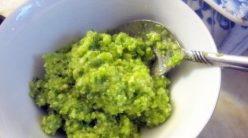Spruce tips are wonderful spring edibles that are not only tasty and unique, but also great for us. They are rich in Vitamin C and have been used traditionally for years to soothe coughs and sore throats, as well as to alleviate lung congestion and to treat lung and kidney infections. Best of all, they’re abundantly available this time of year and great fun to cook with.
Spruce tips are harvested in spring, when the new growth is on spruce trees. In general, they are suitable for foraging anywhere from March through June, depending on the geographical area and also the location of the individual trees. Keep watch of your area spruces and you’ll soon learn the proper time to harvest your local spruce tips.
Harvesting is simple. You only want to gather the light green, tender new growths at the tips of the branches. These may still be enclosed in their paper wrappers if it’s early enough of the season (the wrappers can be simply brushed off). Be sure not to over-harvest too many tips from one tree. Laurie Constantino says:
To harvest spruce tips, pop the tips off the end of the bough as if you’re picking berries. When you’re done picking, remove and discard the papery casings, and discard any hard stem that may have broken off with the tip. The spruce tips are now ready to use.
How to spruce tips taste? Most foragers compare them to a cross between pine and citrus, but each tree will have a slightly unique flavor of its own.
Hunger and Thirst says:
Surprisingly, these coniferous needles don’t just taste like xmas trees smell; they can also have complex citrus top notes – from orange to pomelo to grapefruit – and the taste varies widely from tree to tree.
Cauldrons and Crock Pots describes the flavor of spruce tips:
So often with foraged foods you have something to compare flavours to– for example rose hips have a slightly tangy crab apple flavour– but with these tips, they really have a flavour all to themselves that could only be described as ‘citrus meets conifer’. But that doesn’t even do it justice. You really have to taste the different types of tips, not only to be able to describe it for yourself, but because they are exquisite. Each tree has its own flavour, ranging from more citrusy, to more acrid and coniferous tasting.
PBS’s Kitchen Vignettes produced the video featured here. They write:
Their flavor is reminiscent of Christmas, with a distinct element of citrus and all the vitality of a forest bursting forth in springtime.
You can find the written recipe for their lovely spruce tip jelly here.
For other wonderful ways to use spruce tips, see these recipes:
- Food with Legs has pickled spruce tips.
- Along the Grapevine has directions for using them three ways — chopped with salt (then used in mayonnaise, salad dressing, fish marinade, roasted vegetables and similar dishes), chopped and dried with sugar (then used for baking, added to teas, or to coat the rim of a cocktail glass) and as a syrup (then added to drinks).
- Born in the Wrong Century has a simple recipe for spruce tip vinegar.
- Urban Nettle has a simple “recipe” for spruce tip tea, and also points out that it is noted for curing colds and respiratory ailments.
- Hunger and Thirst has a recipe for spruce gremolata.
- Arctic Garden Studio has a wonderful recipe for rose petal and spruce tip shortbread.
- Cookblog has an assortment of charming ways to use spruce tips, including as spices, rubs and vinegars.
- Mediterranean Cooking in Alaska has a wide variety of recipes, including spruce tip mayonnaise and candied spruce tips.
***
This article originally appeared on examiner.com.





